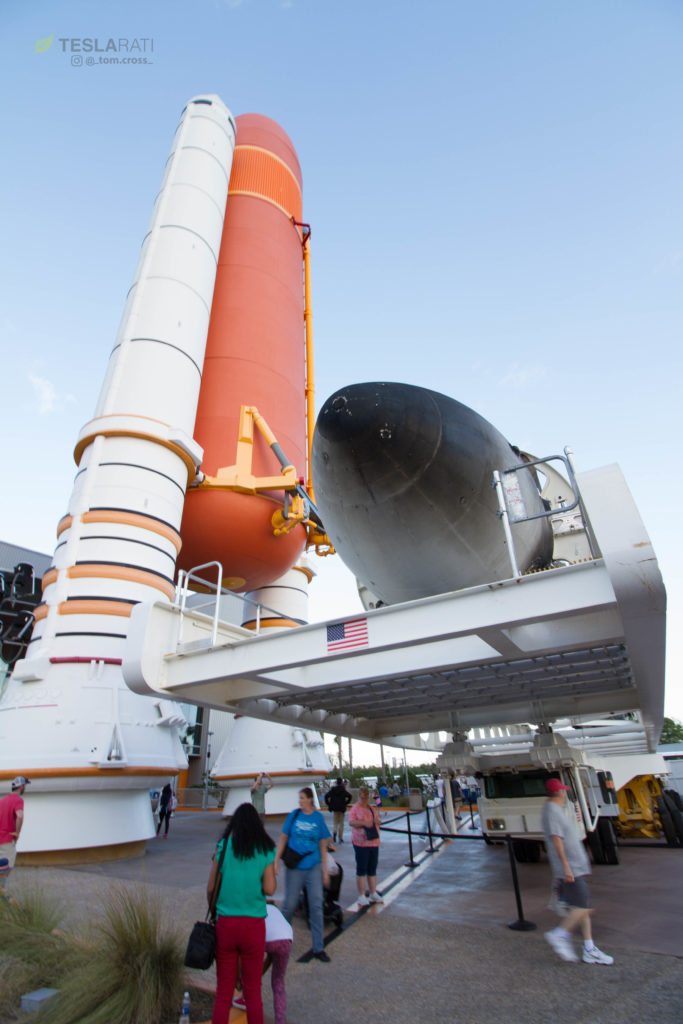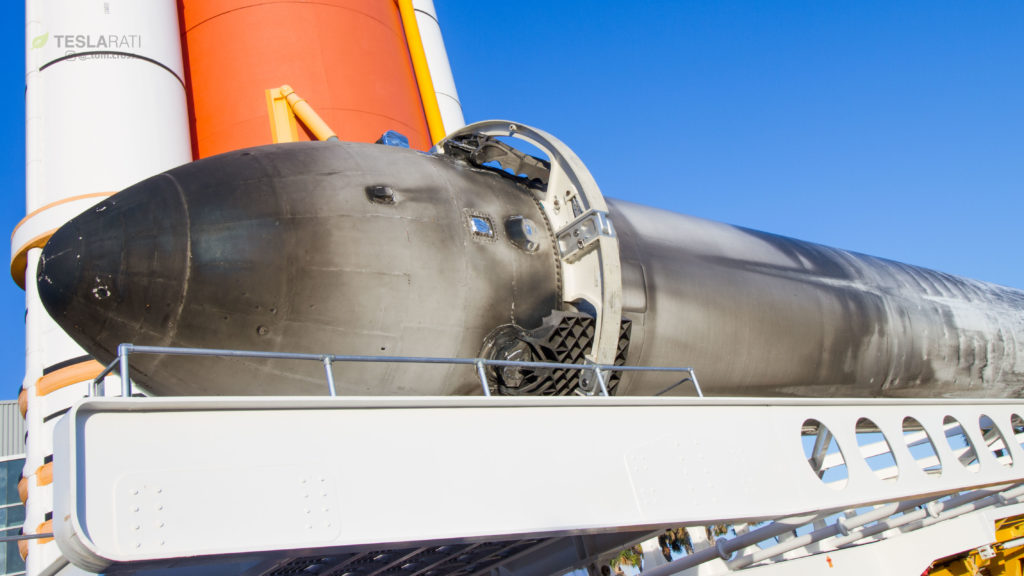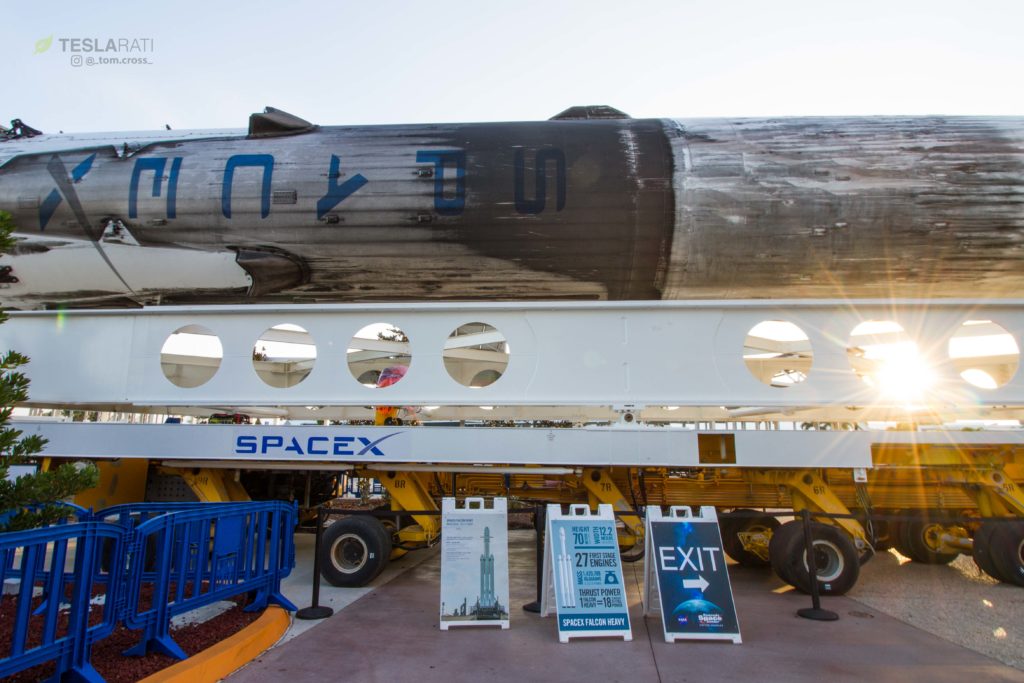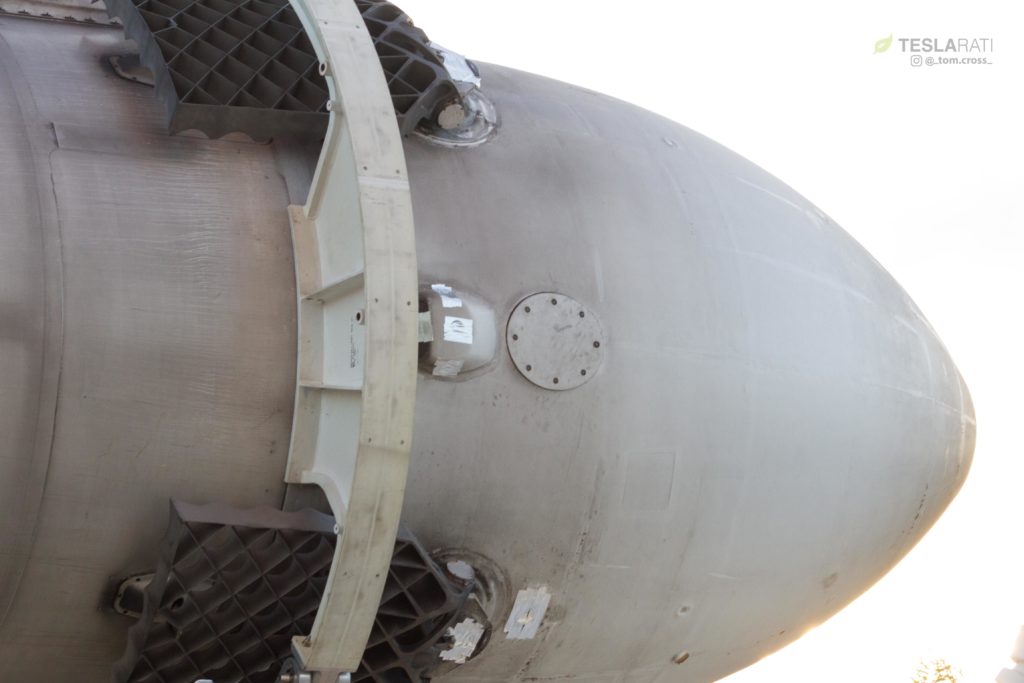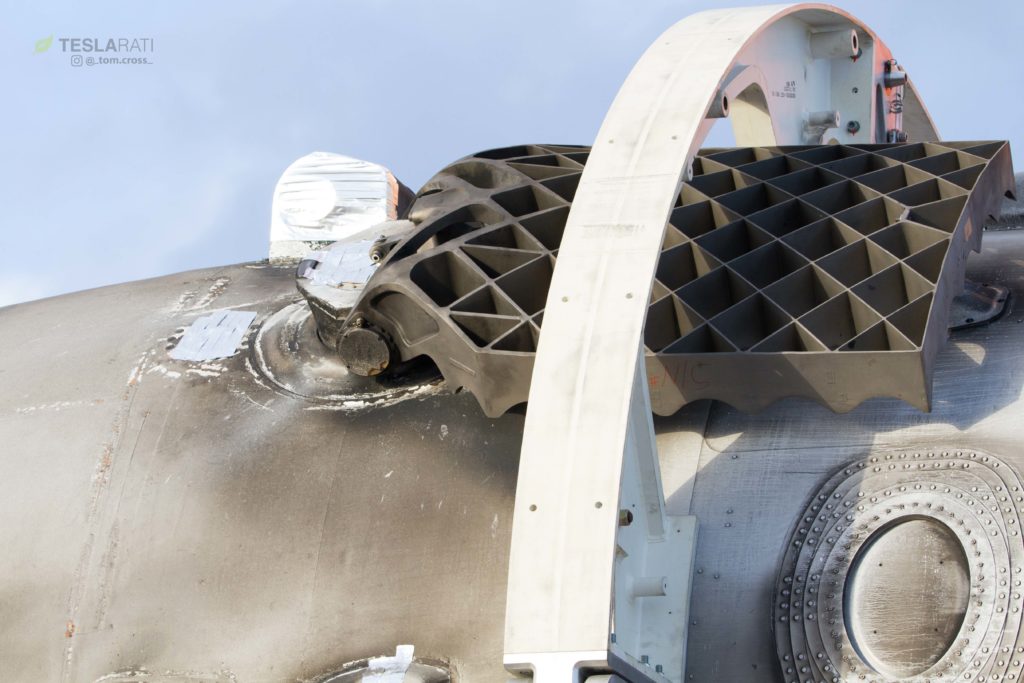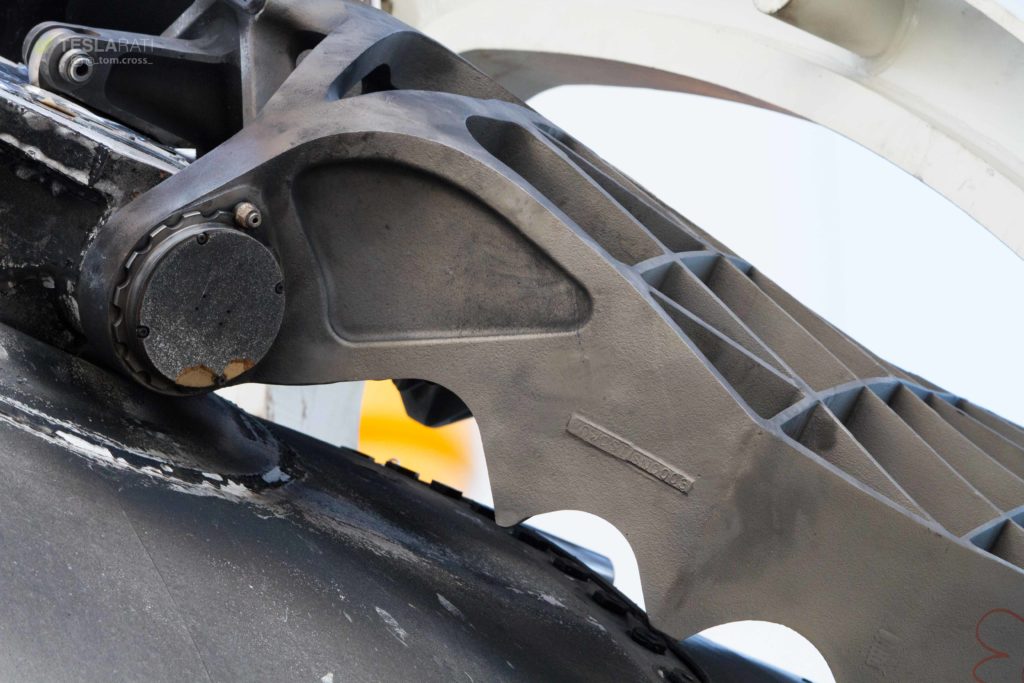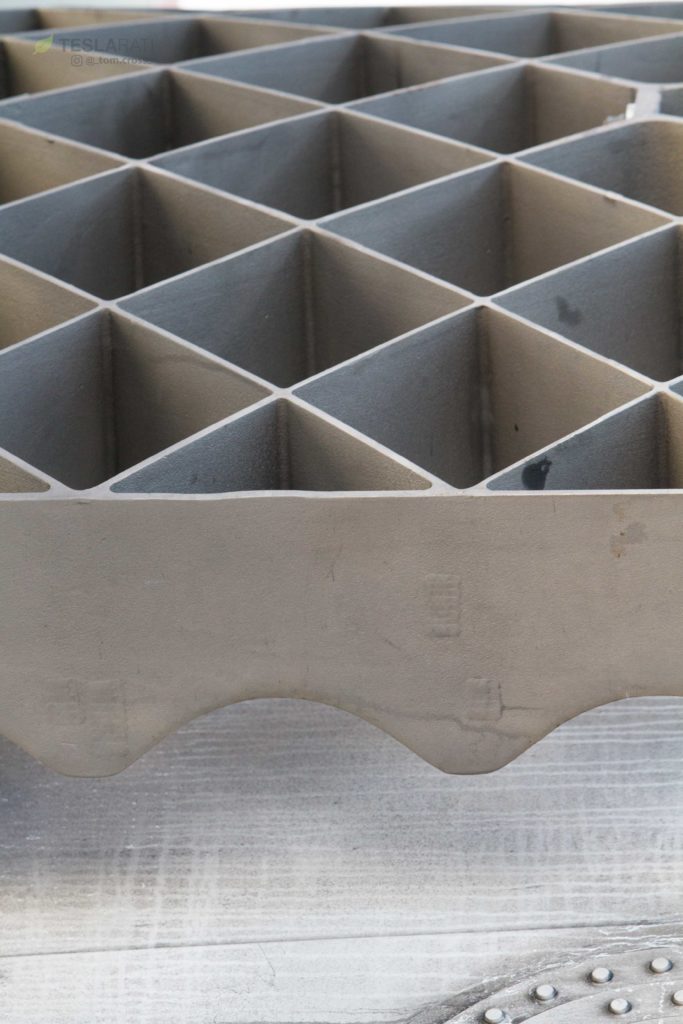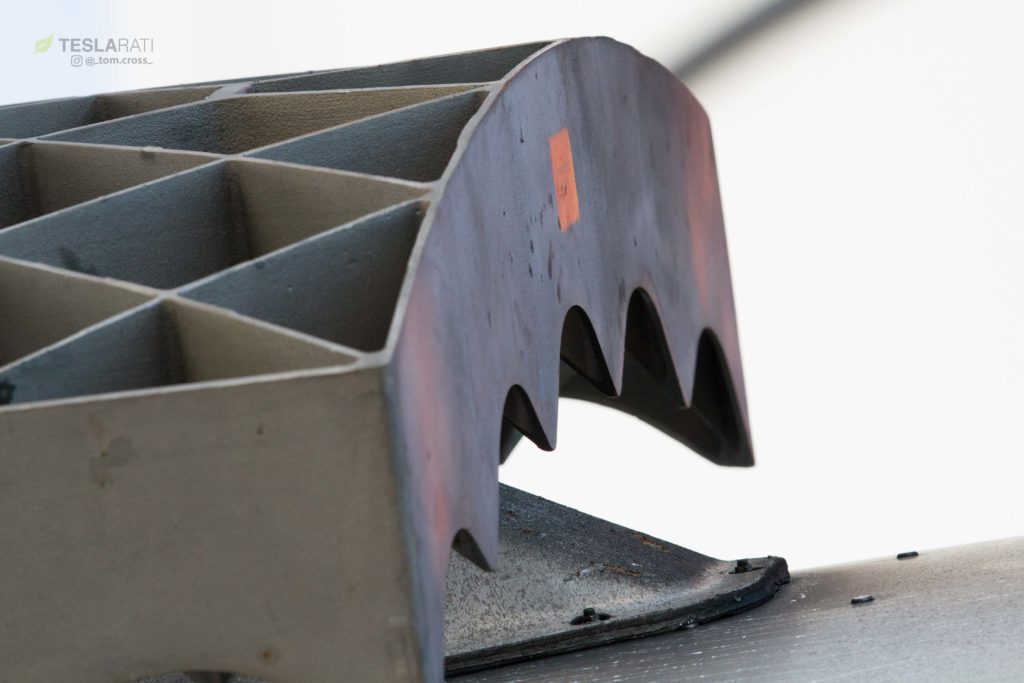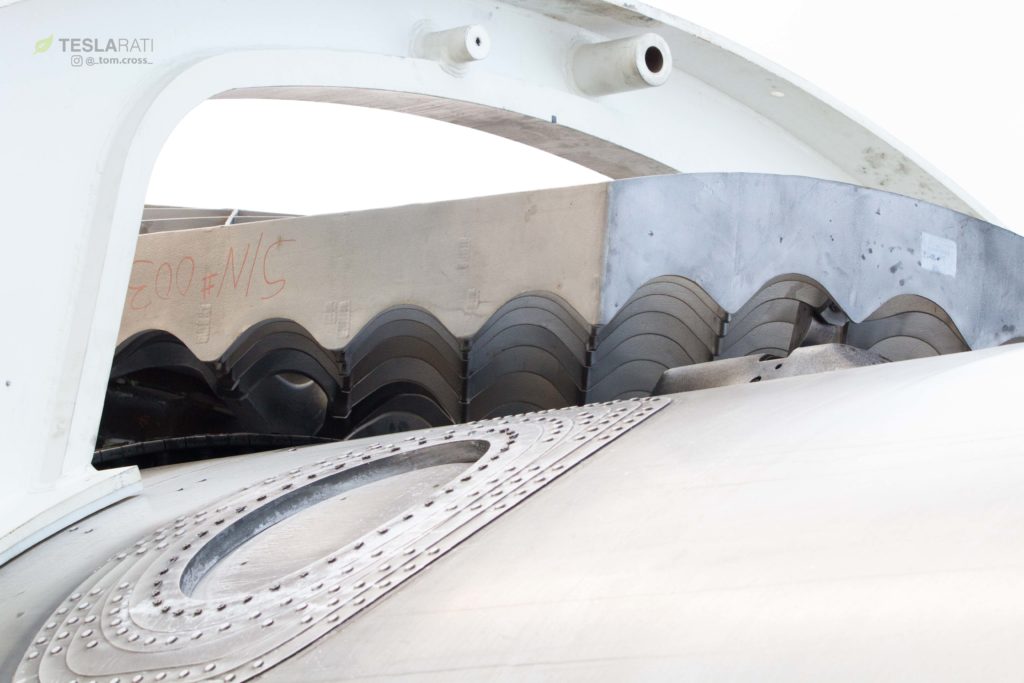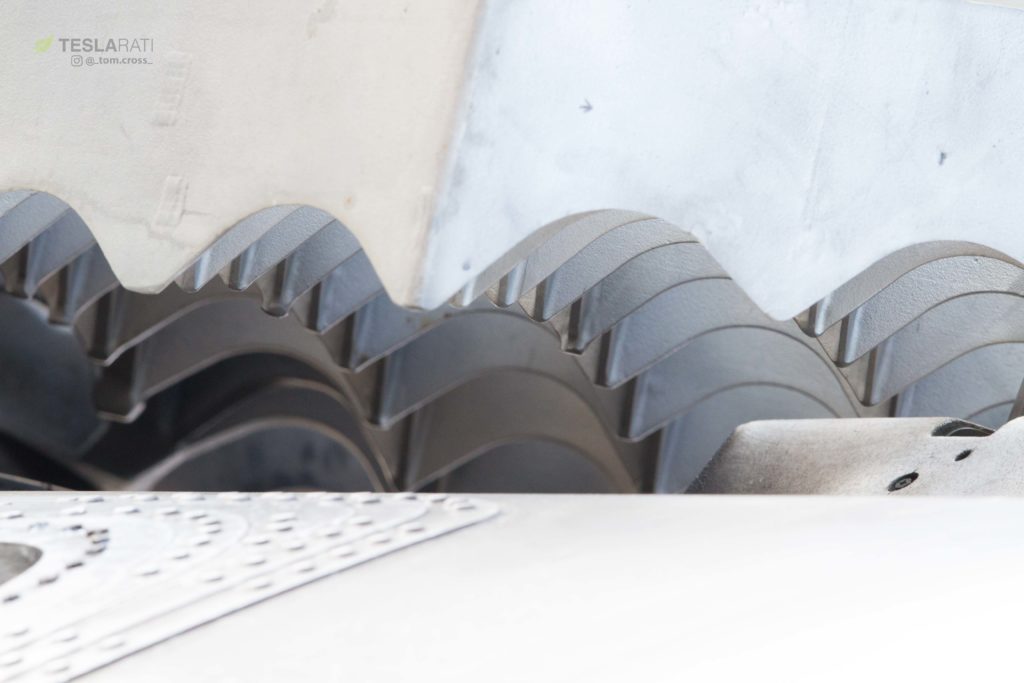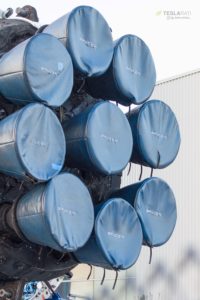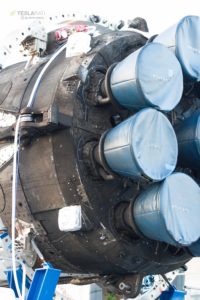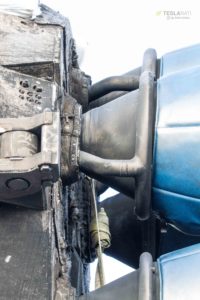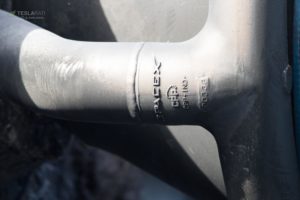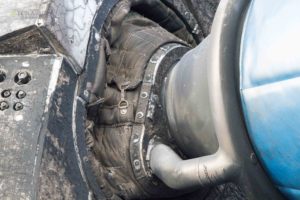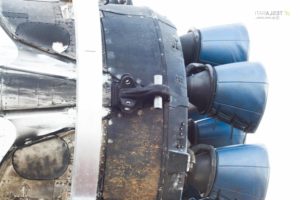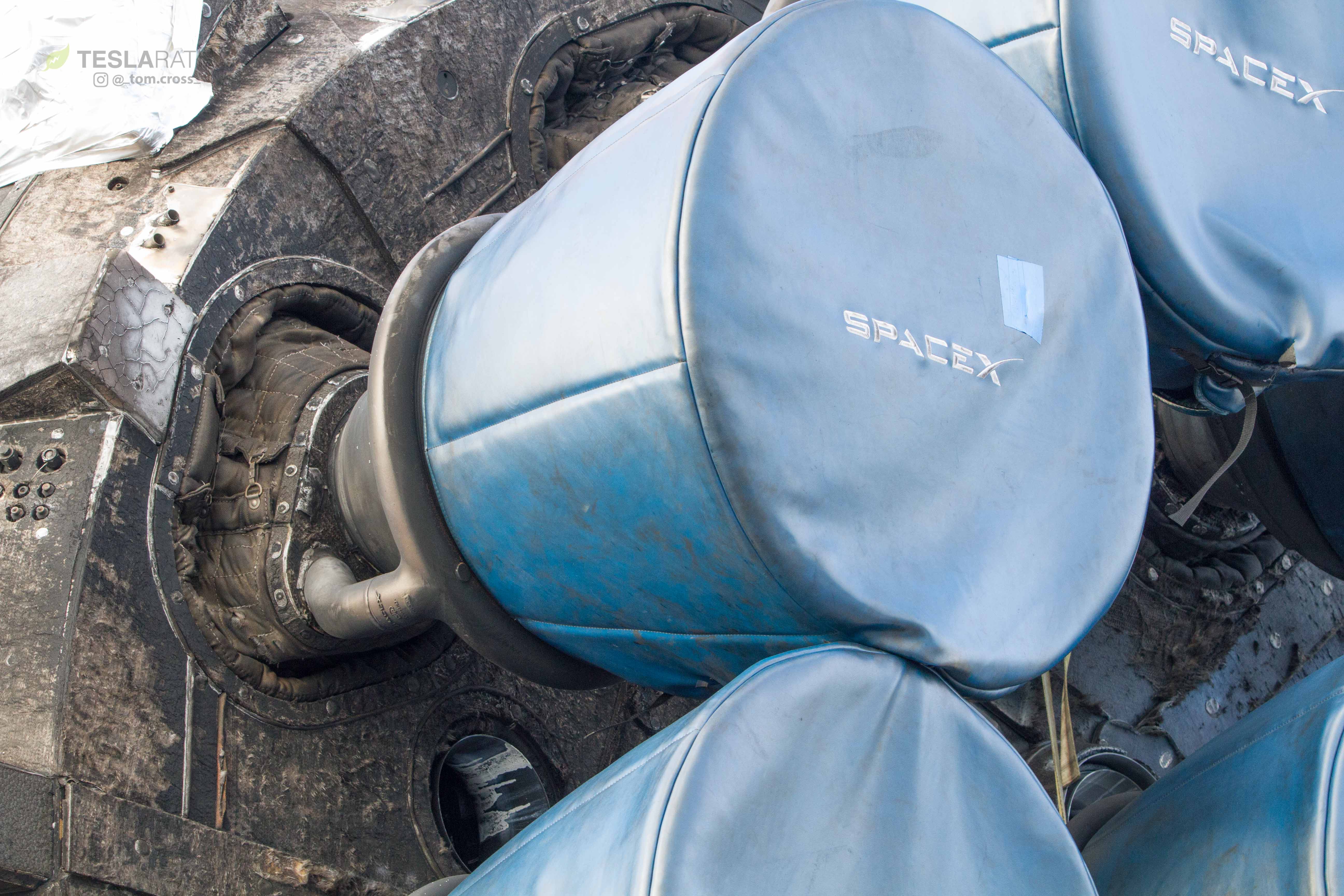

News
SpaceX’s used Falcon Heavy booster shown off in stunning detail [Gallery]
Less than two weeks after SpaceX’s Falcon Heavy performed a simultaneous first-stage landing, the Elon Musk-led space company has completed the process of recovering the massive rocket’s two side boosters, both of which can now lay claim to supporting two separate orbital missions. However, while fascinating in its own right, more interesting is the fact that SpaceX has chosen to very publicly display one of those two boosters front and center at the Kennedy Space Center Visitor Center (KSCVC).
It is likely no coincidence that the National Space Council is scheduled to have their second-ever meeting at Kennedy Space Center this Wednesday. One can readily imagine that SpaceX’s vast, sooty, flight-proven Falcon rockets can be quite an imposing and impressive sight, and it appears that the launch company is hoping to thoroughly impress the Space Council on Wednesday.
- Falcon Heavy’s side booster on display at the Kennedy Space Center visitor complex. (Tom Cross/Teslarati)
- This side booster is Core 1025, the same booster that launched and landed during the CRS-9 Cargo Dragon mission in 2016. (Tom Cross/Teslarati)
- A beautiful sunset eclipsed by SpaceX’s equally beautiful flight-proven Falcon Heavy booster. (Tom Cross/Teslarati)
Regardless of odd and interesting jockeying, the Falcon Heavy booster display is an absolutely unprecedented opportunity in SpaceX history, and Teslarati’s East coast photographer Tom Cross jumped on it. This rocket display is easily the first time the general public has ever been allowed to get so close to fresh rocket hardware, let alone the entire booster of a brand new launch vehicle. Tom has captured some extraordinarily detailed photos of various flight-proven rocket hardware, ranging from titanium grid fins to Merlin engines and even more esoteric parts, like landing leg connecting points.
Titanium grid fins
Appearing nearly unscathed after exposure to reentry temperatures that are often less kind to aluminum, SpaceX’s second flight-test of titanium grid fins has been a resounding success. It’s been hinted by CEO Elon Musk that these massive pieces of cast metal are probably the most expensive individual components on a Falcon 9, and they certainly look every bit the part. Check out these pieces of metalworking art in the best detail yet.

Falcon rockets are constructed largely of aluminum and painted with compounds that are designed to burn off under the heat of reentry, known as ablation. (Tom Cross/Teslarati)
- Falcon Heavy side booster 1025’s flight-proven nose con and grid fins, girdled by one of SpaceX’s rocket transporters. (Tom Cross/Teslarati)
- RIP B1044’s titanium grid fins. May they make a happy little reef at the bottom of the ocean. (Tom Cross)
- Note the serial number, this grid fin appears to be the 3rd titanium fin ever produced- SN00003. (Tom Cross/Teslarati)
- Details of the grid fin. (Tom Cross/Teslarati)
- Rather menacing, eh? (Tom Cross/Teslarati)
- The sinuous curves of the grid fins allow them to better attack the air at the highest pressure points during reentry. (Tom Cross/Teslarati)
- They also happen to look incredibly beautiful. (Tom Cross/Teslarati)
Merlin engines and octaweb details
Taking the brunt of the force and heat of reentry, Falcon Heavy booster 1025’s business end is a powerful display of the intense environment SpaceX’s rockets must survive in order to successfully find their way to land (or sea). Around each Merlin engine is an insulating ceramic fiber blanket intended to protect the more sensitive components of rocket plumbing from the intense heat and buffeting experienced by the engine bells. The octaweb and engine area is also lined with a fair amount of cork – yes, the same material you cork a wine bottle with – designed to sap up the heat of reentry and often ablate. This simple material has worked incredibly well for the rocket company, although it is considerably less than reusable, and likely has to be replaced each launch. Falcon 9 Block 5, expected to begin integrated testing in Texas just days from now, will likely switch to a more reusable material for its octaweb heat shield.

Falcon Heavy booster 1025’s well-worn octaweb. The Merlin engines are underneath their blue cozies. (Tom Cross/Teslarati)

A beautiful capture of one of the booster’s nine Merlin engines, showing off the pipe used to cool the engine bell, as well as the ceramic blanket that protects its more sensitive plumbing. (Tom Cross/Teslarati)
- All nine Merlin 1Ds displayed with their adorable cozies. (Tom Cross/Teslarati)
- Falcon Heavy side booster B1025 gives a sense of the sheer brutality of reentry conditions. (Tom Cross)
- An incredibly detail shot of the side of the octaweb. The large chunk of smooth metal in the center is actually one of the booster’s connection points to the Falcon Heavy center core. (Tom Cross/Teslarati)
- SpaceX’s 338th Merlin engine on display. This particular component circulates cold propellant around the engine bell to cool it down. (Tom Cross/Teslarati)
- A beautiful capture of one of the booster’s nine Merlin engines, showing off the pipe used to cool the engine bell, as well as the ceramic blanket that protects its more sensitive plumbing. (Tom Cross/Teslarati)
- Note the pieces of cork that have been torn off by the buffeting and heat on the lefthand side. (Tom Cross)
Ultimately, this Falcon Heavy booster display is an incredible show of force to the National Space Council, as well as an extraordinary opportunity and inspiration for KSC visitors. Teslarati photographer Tom Cross has given us one of the most detailed looks yet at a complete SpaceX rocket, not to mention such a historic and flight-proven specimen.
The National Space Council meets early tomorrow morning (10:00 am EST, Feb. 21), and will be live-streamed here. SpaceX’s very own President and COO Gwynne Shotwell is expected to be in attendance, and will likely present a brief statement to the council.
Be sure to follow Teslarati’s space team for exclusive backstage access to SpaceX, coast-to-coast:
News
SpaceX’s Crew-11 mission targets July 31 launch amid tight ISS schedule
The flight will lift off from Launch Complex 39A at Kennedy Space Center in Florida.

NASA and SpaceX are targeting July 31 for the launch of Crew-11, the next crewed mission to the International Space Station (ISS). The flight will lift off from Launch Complex 39A at Kennedy Space Center in Florida, using the Crew Dragon Endeavour and a Falcon 9 booster.
Crew Dragon Endeavour returns
Crew-11 will be the sixth flight for Endeavour, making it SpaceX’s most experienced crew vehicle to date. According to SpaceX’s director of Dragon mission management, Sarah Walker, Endeavour has already carried 18 astronauts representing eight countries since its first mission with NASA’s Bob Behnken and Doug Hurley in 2020, as noted in an MSN report.
“This Dragon spacecraft has successfully flown 18 crew members representing eight countries to space already, starting with (NASA astronauts) Bob (Behnken) and Doug (Hurley) in 2020, when it returned human spaceflight capabilities to the United States for the first time since the shuttle retired in July of 2011,” Walker said.
For this mission, Endeavour will debut SpaceX’s upgraded drogue 3.1 parachutes, designed to further enhance reentry safety. The parachutes are part of SpaceX’s ongoing improvements to its human-rated spacecraft, and Crew-11 will serve as their first operational test.
The Falcon 9 booster supporting this launch is core B1094, which has launched in two previous Starlink missions, as well as the private Ax-4 mission on June 25, as noted in a Space.com report.
The four-members of Crew-11 are NASA astronauts Zena Cardman and Mike Fincke, as well as Japan’s Kimiya Yui and Russia’s Oleg Platonov.
Tight launch timing
Crew-11 is slated to arrive at the ISS just as NASA coordinates a sequence of missions, including the departure of Crew-10 and the arrival of SpaceX’s CRS-33 mission. NASA’s Bill Spetch emphasized the need for careful planning amid limited launch resources, noting the importance of maintaining station altitude and resupply cadence.
“Providing multiple methods for us to maintain the station altitude is critically important as we continue to operate and get the most use out of our limited launch resources that we do have. We’re really looking forward to demonstrating that capability with (CRS-33) showing up after we get through the Crew-11 and Crew-10 handover,” Spetch stated.
Lifestyle
EV fans urge Tesla to acquire Unplugged Performance for edge in fleet and security industry
Unplugged Performance has built a name for itself by producing performance upgrades for Tesla vehicles.

A growing number of Tesla enthusiasts and longtime community voices are calling on the electric vehicle maker to acquire Unplugged Performance, a California-based aftermarket company best known for tuning Tesla vehicles and developing specialized government fleet solutions under its UP.FIT division.
The idea was once considered a niche proposal among EV fans, but it is now gaining serious attention not just as a performance play but as a strategic move to deepen Tesla’s roots in the fleet and security industry.
A strategic fit
Unplugged Performance has built a name for itself by producing performance upgrades for Tesla vehicles, from track-optimized components to visual and aerodynamic upgrades. But in recent years, its UP.FIT division has pivoted toward a more functional future by outfitting Tesla vehicles like Model Ys for police, military, and government use.
That work has sparked growing calls for closer collaboration with Tesla, especially as the EV maker increasingly leans into autonomy, AI, and fleet services as core components of its next chapter.
“I posted this four years ago, but I think it’s more true now than ever,” wrote Whole Mars Catalog, a well-known Tesla investor and FSD Beta tester, on X. “Tesla should buy Unplugged. But not just as a Performance division. What they are doing with UP.FIT unlocks large government and commercial fleet purchases that can improve utilization.”
Tesla fans such as shareholder Sawyer Merritt echoed the sentiment, calling Unplugged a “great fit within Tesla.” adding, “They are literally located directly next to Tesla’s design studio in Hawthorne.”
Enabling the next wave
Supporters of the idea noted that integrating Unplugged into Tesla’s corporate structure could help accelerate the adoption of autonomous technologies in government sectors. With UP.FIT patrol cars already in use across some U.S. police departments, Tesla fans envisioned a future where self-driving Teslas could potentially revolutionize law enforcement, search-and-rescue, and public service logistics.
“Just imagine how autonomous patrol cars could transform policing and bring us into a safer future,” the veteran FSD tester wrote.
The benefits could also extend to Tesla’s existing consumer base. “They also have some incredible products in the works that I think will appeal to many ordinary Tesla drivers — not just those looking for performance or mods. Stuff that’s so good it should have come straight from the design studio next door,” Whole Mars Catalog noted.
Unplugged Performance, founded in 2013, shares not just a product vision with Tesla, but also geography. Its Hawthorne headquarters sits directly adjacent to Tesla’s design studio, and the two companies have maintained a close working relationship over the years. The aftermarket firm has long positioned itself as a “mission-aligned” partner to Tesla.
In response to the recent calls for acquisition, Unplugged Performance acknowledged the support from the community. “Our very existence is to support the Tesla mission with @UpfitTesla and @UnpluggedTesla,” Unplugged CEO Ben Schaffer posted on X. “We love working with Tesla and are grateful for the community’s support since 2013!”
News
Tesla debuts hands-free Grok AI with update 2025.26: What you need to know
All new Tesla vehicles delivered on or after July 12, 2025, will include Grok AI out of the box

Tesla has begun rolling out Grok, an in-car conversational AI assistant developed by xAI, to eligible vehicles starting July 12. The feature marks the most direct integration yet between Elon Musk’s artificial intelligence startup and Tesla’s consumer product lineup, offering drivers hands-free access to a chat-style companion while on the road.
Grok comes pre-installed on new vehicles
According to Tesla’s FAQ page for the feature, all new vehicles delivered on or after July 12, 2025, will include Grok AI out of the box. Owners of older vehicles may gain access through an over-the-air update, provided their vehicle meets a few hardware and software requirements.
Specifically, Grok is currently only supported on Tesla models equipped with an AMD infotainment processor and running vehicle software version 2025.26 and higher. Compatible models include the Model S, Model 3, Model X, Model Y, and Cybertruck. A Premium Connectivity subscription or active Wi-Fi connection is also required.
Tesla notes that additional vehicle compatibility may arrive in future software updates.
Grok’s features and limitations for now
Drivers can engage with Grok using the App Launcher or by pressing and holding the voice command button on the steering wheel. Grok is designed to answer questions and hold conversations using natural language, offering responses tailored to its chosen personality—ranging from “Storyteller” to the more eccentric “Unhinged.”
For fun, Tesla posted a demonstration of Grok likely running on “Unhinged” talking about what it would do to Optimus when they are on a date, much to the shock of the humanoid robot’s official social media account.
It should be noted, however, that Grok cannot currently issue commands to the vehicle itself, at least for now. Traditional voice commands for tasks like climate control, navigation, or media remain separate from Grok as of writing.
The feature is being released in Beta and does not require a Grok account or xAI subscription to activate, although that policy may change over time.
Grok privacy and in-car experience
Tesla emphasizes that interactions with Grok are securely processed by xAI and not linked to a user’s Tesla account or vehicle. Conversations remain anonymous unless a user signs into Grok separately to sync their history across devices.
Tesla has also begun promoting Grok directly on its official vehicle webpages, showcasing the feature as part of its in-car experience, further highlighting the company’s increasing focus on AI and infotainment features on its all-electric vehicles.
-

 Elon Musk2 weeks ago
Elon Musk2 weeks agoTesla investors will be shocked by Jim Cramer’s latest assessment
-

 Elon Musk2 days ago
Elon Musk2 days agoxAI launches Grok 4 with new $300/month SuperGrok Heavy subscription
-

 Elon Musk5 days ago
Elon Musk5 days agoElon Musk confirms Grok 4 launch on July 9 with livestream event
-

 News1 week ago
News1 week agoTesla Model 3 ranks as the safest new car in Europe for 2025, per Euro NCAP tests
-

 Elon Musk1 week ago
Elon Musk1 week agoxAI’s Memphis data center receives air permit despite community criticism
-

 News2 weeks ago
News2 weeks agoXiaomi CEO congratulates Tesla on first FSD delivery: “We have to continue learning!”
-

 News2 weeks ago
News2 weeks agoTesla sees explosive sales growth in UK, Spain, and Netherlands in June
-

 Elon Musk2 weeks ago
Elon Musk2 weeks agoTesla scrambles after Musk sidekick exit, CEO takes over sales

